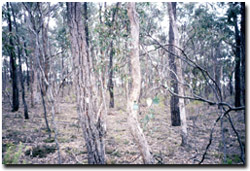Site 18 Pilchers Bridge Flora and Fauna Reserve
The Site is in a stable environmental condition
Description
Pilchers Bridge is Box-Ironbark forest at an elevation of 310 metres and is now reserved for conservation as a Flora and Fauna Reserve. The entire area was clear felled in the 1930s and the vegetation has been heavily modified by previous clearing and gold exploration activities. The site has moderate habitat value due to its large size and minimal weed invasion.
The area could benefit from some ecological thinning to increase the habitat value of the site. A reduction in the number of stems per hectare would open the site up to let more sunlight through and to allow some of the trees to develop larger diameters.
| Vegetation Description and Composition This intact Box-Ironbark Forest site is dominated by Eucalyptus tricarpa (Red Ironbark), Eucalyptus macrorhyncha (Red Stringybark), Eucalyptus polyanthemos (Red Box), Eucalyptus microcarpa (Grey Box) and Eucalyptus leucoxylon (Yellow Gum). The EVC is Box-Ironbark Forest, listed as depleted in the Goldfields Bioregion. The understorey has a range of Wattles, Heaths, Peas and native grasses. Many Wattle seedlings are still present and have been identified as Acacia acinacea (Gold-dust Wattle). Compared to previous results, the 2002 survey recorded four less species and the total level of abundance of all species was reduced. The reasons for the changes were the prolonged dry conditions and grazing by kangaroos. |  Pilchers Bridge Reserve |
No introduced or salt indicator species have ever been recorded at this site.
There appears to be more leaf litter than the previous five years of vegetation surveys caused by extended dry conditions.
Tree Health
Four trees are monitored for tree canopy health using a 20-point system assessing canopy size and density, number of dead branches and extent of epicormic growth. Leaf damage by insects is also assessed. Tree health is fairly low because the trees have very small canopies and reduced canopy densities as a result of the drought and the reserve containing too many stems per hectare. Elevated tree density is a common problem in nearly all Box-Ironbark remnants, caused by previous clearing activities and the subsequent coppice regrowth.
Groundwater and Salinity
A bore was installed in the reserve in 2001 to a depth of 17 m and has remained dry, therefore the water table is deeper than 17 m below natural surface.
Birds
Bird species present at the time of the vegetation and tree health surveys were :-
Brown Treecreeper, Brown-headed Honeyeater, Buff Rumped Thornbill, Eastern Rosella, Fuscous Honeyeater, Galah, Kookaburra, Magpie, Mistletoe Bird, Noisy Miner, Red Wattlebird, Spotted Pardalote, Superb Fairy-wren, White-plumed Honeyeater, White-winged Chough and Yellow-tufted Honeyeater.
Threats to the site include
- heavy grazing by kangaroos.
- possible future fuel reduction burns.


